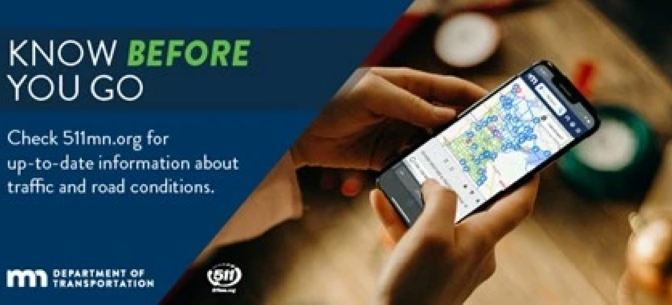Navigation apps can be valuable timesavers for drivers in Minnesota. To maximize their use, these apps need traffic information that is timely and accurate. While state highway closures are reported effectively, reporting road closures on local roads and highways is inconsistent. This project aimed to improve local road closure reporting by exploring the development of a streamlined reporting system and creating guidance for reporting local road closures to third-party navigation apps.
To reach their destinations as quickly as possible, Minnesota drivers want to be alerted to road closures that could potentially cause them a significant delay. Along with wanting this information, drivers would like road authorities from across the state to deliver the information in a consistent and dependable way. However, disseminating local road closure information can be difficult. Currently each local agency must provide road closure information directly to the third-party navigation apps.
To improve upon current practices, LRRB conducted research to determine a user-friendly approach for local agencies to report road closures. The recommended reporting system would interface with MnDOT and third-party navigation apps to relay road closure information to drivers. This project also created a summary guide for local agencies to report road closure information directly to third-party navigation apps.
What Did We Do?
This project had two primary objectives: to identify the best process for LRRB to implement a user-friendly road closure system for local roads and to create a guide for local agencies to report road closures directly to third-party navigation app companies.
To determine an effective reporting process, the investigators analyzed three alternatives:
- Partnering with MnDOT to adapt a statewide condition reporting system.
- Developing a stand-alone statewide condition reporting system independent of MnDOT.
- Developing individual county and city road closure condition reporting systems.
The analysis identified the best practices of each option by reviewing and interviewing transportation agencies that operated these systems in Iowa, Maryland, Minnesota, North Dakota and Oregon.
“This research provides guidance for integrating local road closure information into commercial navigation apps and investigates possible collaborations with the goal of better serving the traveling public,” Perry Clark, asset manager, Carver County Public Works.
Next, investigators developed a guide that would support local agencies as they directly report road closure information to third-party navigation apps. Development of this guide included an online review of five navigation app providers, input from LRRB staff with road closure reporting experience and a review of documentation specific to reporting road closures to third-party navigation apps. The navigation apps reviewed for the guide were Apple, Google, HERE, TomTom and Waze.
What Was the Result?
The research and analysis conducted as part of this project provided insight into the best alternative for local agencies to pursue. Partnering with MnDOT to adapt a statewide condition reporting system was chosen as the best option. Below are key highlights associated with this approach:
- This option would only be possible if MnDOT agrees to participate in the implementation.
- Initial estimated development costs will range from $75,000 to $150,000 (the least expensive of the three options considered).
- Ongoing operation costs are estimated to range from $50,000 to $75,000 per year.
- Implementation would be faster because the project would use the existing MnDOT contract and avoid the need for a procurement process.
- One statewide system would streamline changes if the types of entered events are expanded beyond road closures (for example, construction zones).
Additionally, a four-page guide was developed that provides easy-to-follow steps and instructions for local agencies to provide road closures to third-party navigation apps. The guide provides directions to directly email road closure information to each navigation app, use online tools to enter road closure information for each app or establish an interface with each navigation app to transfer road closure information.
What’s Next?
Based on the results of this project, local agencies will pursue a relationship with MnDOT to adapt and use a statewide condition reporting system. Next steps include holding discussions with MnDOT to determine its willingness to participate, asking for and reviewing feedback from local agencies regarding the implementation of this system and identifying funding opportunities and cost shares. Additionally, administrative responsibility (which includes system training and maintenance) must be assigned.
While this proposed project is under consideration, local municipalities can begin using the guidance developed in this project to efficiently report local road closures directly to third-party navigation apps.

